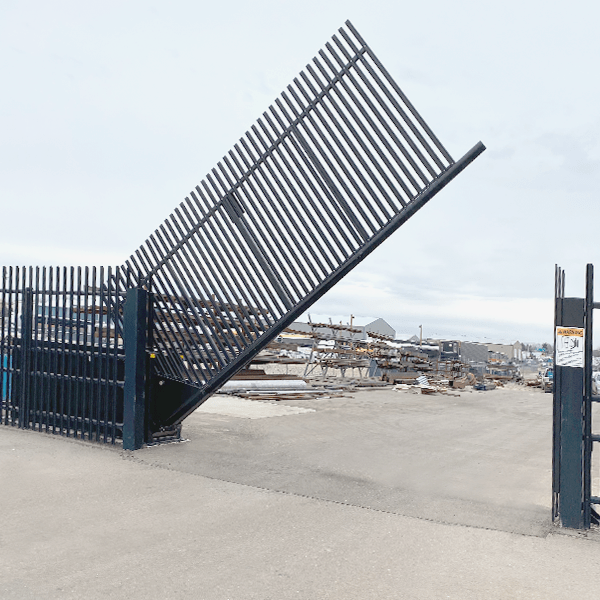Automated Gates: What to Know Before Choosing One
- IronSite Education

- Oct 14
- 6 min read
Different types of gates and their uses, key considerations, and other factors to keep in mind
Table of contents:
Introduction:
When it comes to automated gates, there’s no shortage of options. Choosing the right one for your site helps maximize protection, minimize disruption, and stay on budget.
This article outlines the main types of automated gates and what to consider before choosing one, from installation requirements to cost and performance factors.
Types of automated gates
While each type of gate has varying degrees of customization options, at a high level there are only a handful of different types of residential, commercial, or industrial automated gates. Each type of gate has something slightly different to offer–they function differently, offer varying levels of protection, come in different sizes, offer multiple material options, and additional security features like alarms or signage. Different types of automated gates are:
Slide Gates: Popular for residential and commercial use; move horizontally on rollers or tracks; customizable but may need more upkeep in harsh weather.
Swing Gates: Simple and low maintenance; open inward or outward; require swing clearance and level ground.
Cantilever Gates: Ideal for industrial or heavy-duty sites; trackless design reduces maintenance; higher cost and wind load.
Bi-fold Gates: Compact and fast (often open/close in under 8 seconds); great for tight spaces but more complex to install.
Vertical Pivot Gates: Lift upward to save space; good for high-traffic or sloped sites; limited design flexibility.
Types of gate operators
In addition, each gate will need an operator to open and close the gate. These can be hydraulic, electromechanical, rack driven, or chain driven. Like a bicycle chain, chain driven operators utilize a roller chain to move the gate back and forth along a track and are more suitable for heavy gates.
Rack driven operators are low maintenance operators that employ a grooved track called a ‘rack’ that’s controlled by a motorized gear to open and close.
Operating at a lower voltage than other designs, electromechanical operators typically utilize an internal threaded rod to push and pull the gate when it receives a signal from an integrated control panel.
Hydraulic operators, praised for their power, pumps hydraulic fluid through a closed loop system to apply pressure on a piston system that opens the gate. When the gate needs to be closed, valves simply reverse the flow of hydraulic fluid, relieving the pressure applied by the piston system and closing the gate.
Factors to consider
Opening Size & Width:
Larger spans (40+ ft) increase cost and risk of operational issues.
Choose a gate type suited to your width (cantilever, bi-fold, vertical pivot for large spans).
Space & Installation Constraints:
Consider clearance for slide or swing operation; limited sites benefit from vertical or folding gates.
Excavation & Ground Conditions:
Account for utilities, drainage, and power access. Flat, level surfaces are ideal; uneven terrain may favor cantilever or pivot designs.
Cycle Frequency & Speed:
High-traffic sites need industrial operators and faster gate types (cantilever, bi-fold, pivot).
Climate & Environment:
Weather extremes (snow, wind, heat) affect gate durability and operator performance. Choose corrosion-resistant materials and proper drainage.
Space, site, and environmental considerations
Before choosing an automated gate, think about how much space you have to work with—both above and below ground.
Slide gates need enough room on one side of the road or driveway to store the gate when it’s open.
Swing gates require space for the gate to fully swing open without obstruction.
If you’re in a tight or urban area with limited clearance, slide, bi-fold, or vertical pivot gates are typically the best options.
Ground conditions also affect installation. Excavation work may involve:
Burying hydraulic or electrical lines
Routing power and sensor wiring
Avoiding underground utilities
Providing proper drainage
Establishing reliable power in remote areas
Because most gates operate best on level ground, uneven surfaces can increase wear on motors and operators. Cantilever, bi-fold, and vertical pivot gates handle slopes or irregular grades more effectively.

Usage frequency matters too. Gates that open and close many times a day need durable, industrial-grade operators and faster opening speeds to prevent traffic delays or tailgating risks. Bi-fold, cantilever, vertical pivot, and slide gates are well-suited for high-traffic applications.
Finally, consider your local climate. Extreme temperatures, heavy snow, high winds, or ice buildup can strain automated gate systems and shorten their lifespan. Choose designs and materials that can withstand your specific weather conditions and maintain reliable operation year-round.
Cost and maintenance factors
The cost of an automated gate can vary widely depending on several factors. The type of gate and the width of the opening have the biggest impact—larger gates with advanced safety features naturally cost more than smaller, simpler designs.
Installation conditions also play a major role. Sites that require significant excavation, trenching for power or control wiring, or specialized foundations will increase overall project costs.
Automated gates rely on multiple moving parts—tracks, rollers, hinges, and safety sensors—that need regular maintenance to operate reliably. Over time, environmental conditions can influence maintenance needs and long-term expenses:
Cold climates may require built-in heaters to prevent freezing.
Areas using de-icing salts can experience faster corrosion.
Urban or industrial settings with high dust or pollutants may need more frequent cleaning and service.
Factoring these elements into your budget helps ensure your gate performs reliably and minimizes unexpected repair costs down the line. Below is a comparison chart that highlights some differences between the various gate designs:
Type | Approx. Price Range* | Install Time | Space Needed | Ideal Use Case |
Slide Gate | ~$2,000 | 3-4 days | Space equal to 2x the gate opening | Residential, Industrial, Commercial, Government, Utilities |
Bi-folding Gate | $8,000 - $10,000 | 3-4 days | Space equal to gate width + hinge clearance | Tight spaces, Parking facilities, Industrial parks, Government or Utility sites |
Swing Gate | $2,000 | 1-3 days | Swing arc equal to full gate width + room for posts | Residential, Private communities, Agricultural or light industrial use |
Cantilever Gate | $2,000 | 3-4 days | 1.5x gate opening | Industrial, Military, Airport, Utility, and Commercial sites |
Vertical Pivot Gate | $4,000 | 3-4 days | Gate width plus vertical clearance for raised position | High-security, Space-limited, or Harsh-weather sites |
*Price ranges reflect general cost per foot of clear opening. Actual pricing varies by configuration, material, and site conditions.
Additional Considerations for Automated Gates
Before selecting an automated gate, it’s important to evaluate a few key factors beyond cost and installation:
Level of Protection Determine the level of security your site requires. Many automated gates are crash-rated, designed not only to manage traffic but to withstand or stop intentional vehicle impacts. To learn more about crash ratings and how they apply to gates, visit our Crash Ratings explained webpage.
Safety and Compliance
Automated gates must also meet strict safety standards to protect personnel and bystanders. The UL325 standard ensures your system is designed, manufactured, and installed to minimize risk and deliver consistent performance. Compliance with UL325 helps ensure:
Prevention of entrapment during gate operation
Reliable performance in demanding conditions
Fulfillment of regulatory safety requirements
Reduced legal and liability risk for businesses
Integrated Security Systems
For maximum protection, automated gates can be integrated with other perimeter security technologies, such as:
Access control systems (keypads, card readers, biometrics, or ALPRs)
Intrusion detection that automates gate operation in response to real-time threats
Security barriers (bollards, wedge barriers, drop arms, or rising beams) that work in sync with the gate for layered protection
This integrated approach enhances situational awareness, improves response times, and strengthens perimeter defense.
Ongoing Maintenance
Automated gates require regular service to maintain performance and reliability. This includes:
Lubricating and inspecting mechanical components
Cleaning debris from tracks and sensors
Checking operator function and safety systems
Neglecting maintenance can lead to premature wear, system failure, and increased vulnerability to security breaches.
Conclusion:
Automated gates simplify access control while enhancing security for vehicles and pedestrians. Choosing the right gate for your site can feel complex, but careful planning prevents costly replacements, downtime, and safety issues. The IronSite team is ready to help you design and implement the ideal gate solution. Explore our Automated Gates Buying Guide for an in-depth look at gate types, installation considerations, and a side-by-side comparison chart to make your decision easier.
IronSite is a national physical security provider with specialized expertise to deliver premium solutions at scale. Our extensive family of brands nationwide enables responsive and consistent service and support for all our clients wherever they may be.
Media Contact
Terin Pickett
IronSite
1595 E. 6th St; Suite 101
Corona, CA 92879










Comments